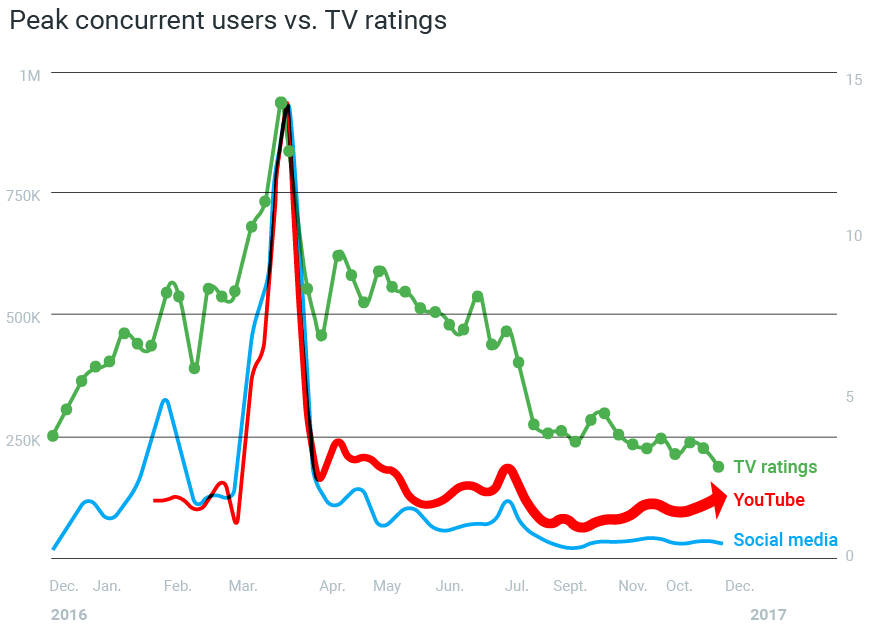- A clip from Workpoint Digital TV’s “The Mask Singer”—the biggest TV show in Thailand’s history—topped YouTube’s global trending videos in 2017.
- The video’s success is attributed to the company’s innovative digital strategy: simulcasting across TV, YouTube, and social media.
- Marketers can glean three lessons from Workpoint Digital TV’s approach: understand your audience, testing and learning is important, and understand how to fully leverage various digital platforms.
Workpoint Digital TV’s “The Mask Singer” is a weekly Thai music reality TV program featuring celebrities performing behind masks. Not only has it quickly become the biggest TV show in Thailand’s history, but a YouTube clip from the show’s second season recently topped YouTube’s global trending videos in 2017, with more than 217M views and counting.
The video’s success, however, was no accident: Workpoint Digital TV—a YouTube partner—was the first Thai media company to pioneer simulcasting across TV, YouTube, and social media. The innovative approach helped the company build a passionate fan following across multiple digital channels and video platforms.
Learn more about three important marketing lessons gleaned from the #1 global viral video of 2017 below.
1. Understand your audience
Brands and marketers need to truly understand today’s audiences and where they spend their time.Thais lead the world in multi-screening and multitasking, so Workpoint Digital TV knew it couldn’t just rely on traditional platforms like TV to reach them. What’s more, 89% of Thai internet users access YouTube daily1, making combining online and offline absolutely necessary.

“We do our homework and make decisions based on what we see and feel,” said Chalakorn Panyashom, CEO of Workpoint Digital TV. “We need to be open to change as consumer behavior progresses, and we have to be able to follow them in time. Wherever audiences are, we have to be there.”

2. Test, measure, learn, and optimize
It’s important to take advantage of the tools and features available on digital video platforms. As a YouTube partner, Workpoint Digital TV has always experimented with suggestions from the YouTube team—from scheduled live events to strategic ad insertion to custom thumbnails.
For example, during the TV broadcast’s four- to five-minute commercial break, the first few YouTube simulcast videos would display a static image with the message “We will be right back after the break.” When audience retention reports in YouTube Analytics showed that viewership dropped off considerably, the team swapped the image with clips promoting old episodes or other Workpoint Digital TV shows to keep users engaged. The result? A 3% lower drop rate and an opportunity for more advertising and branded content on the channel.
Audience retention reports are one of many reports in YouTube Analytics that Workpoint Digital TV closely monitors and acts on. Tasked with handling a massive influx of audience data, the company hired new staff to focus solely on YouTube Analytics, but much of the real-time feedback was still closely monitored by Panyashom himself. The data helped the team understand what connected with audiences, allowing them to tweak and optimize content based on viewer interests.
By promoting a culture of experimentation and encouraging its team to test new ideas, Workpoint Digital TV was able to reach its audience in a more engaging and meaningful way. “This is the real beauty of digital—audience voice,” said Panyashom. “It is something that TV never offered us before.”
3. Understand and smartly leverage various digital channels
Today’s digital platforms allow audiences to interact with brands. And while the audience for each platform can differ, the ways and the reasons audiences turn to certain platforms vary greatly.

Panyashom encouraged his team to record audience metrics like peak concurrent users across YouTube and social media mapped against TV ratings. During season one (Dec—April), the show’s peak concurrent users grew by 10—15% each week, but the team saw differences in audience behavior across video platforms. On YouTube, the average view duration for each video was 13.84 minutes. This was especially impressive because the show was divided into five 16-minute segments, which meant viewers essentially watched the entirety of each video. From this, the team understood that YouTube had a better retention rate for long-form, episodic content. The data also revealed that simulcasting across digital platforms did not dilute TV ratings but instead complemented traditional media.
The learnings from season one of “The Mask Singer” were carried over into season two (April—Aug), which led to the “oyster mask” clip becoming the #1 YouTube global trending video of 2017. Data also showed that YouTube’s baseline shifted after season one, outperforming social media in terms of peak concurrent users. Workpoint Digital TV also saw that its YouTube channel, which had grown to 11M subscribers, had become a loyal viewing destination for its passionate fan base.
“When we decide to grow with a platform, we have to use every tool from the platform. We can then measure whether or not it matches with the platform’s audience. If we did all that the platform suggested and the video did not do well, then it implied the problem was our own content,” concluded Panyashom.







